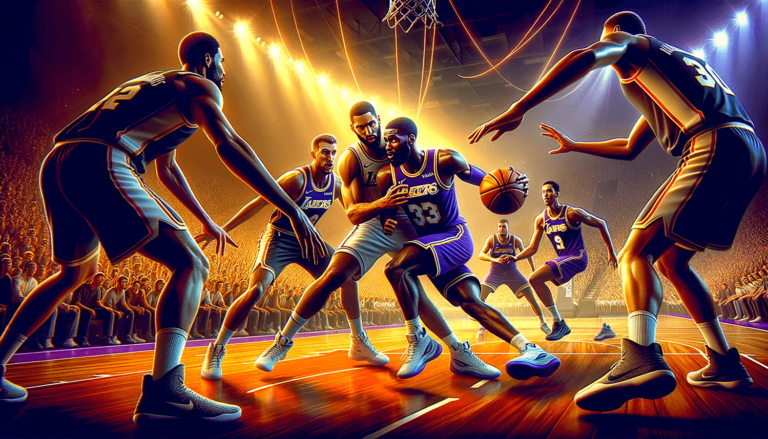
Welcome to the exhilarating world of basketball! In this blog post, we’ll be diving into one of the most fundamental and effective plays in the game: the pick and roll. Whether you’re an aspiring athlete, an avid fan, or a basketball enthusiast eager to expand your knowledge, you’ve come to the right place. Let’s roll up our sleeves and embark on an exciting journey to unlock the secrets behind the pick and roll, a play that can turn the tide of any match when executed to perfection.
What’s a Pick and Roll in Basketball?
A pick and roll in basketball is a two-player offensive play that involves one player, the screener, setting a pick (screen) on a defender to momentarily block their path, allowing the ball-handler to drive towards the basket or find an open shot. After setting the pick, the screener then “rolls” towards the basket, creating an opportunity for a pass and a potential scoring chance. This maneuver requires good communication, timing, and teamwork to be effective.
Discovering the Origins of the Pick and Roll
Even though it’s difficult to pinpoint the exact origin of the pick and roll in basketball, this play has been an essential part of the sport since its early days. As the game evolved and players started recognizing the importance of teamwork and strategic plays, coaches integrated the pick and roll into their offensive schemes. Since then, it has remained a staple, providing numerous memorable moments and countless top-tier plays on the court.
Understanding the Roles in a Pick and Roll
The success of a pick and roll relies on the collaboration of two main roles: the ball-handler and the screener. Let’s break down the responsibilities and requirements of both these roles to better understand the mechanics of this strategic play.
The Ball-Handler
The ball-handler is the player who initiates the pick and roll by dribbling the ball near the screener. This player should have excellent ball-handling skills and court vision to capitalize on the play’s potential. The ball-handler should be able to read the defense, make accurate passes, and take advantage of any scoring opportunities that arise from the pick and roll action.
The Screener
The screener is the player who sets the pick on the defender guarding the ball-handler. Typically, this role is played by a forward or a center with good size and strength. The player must be adept at setting strong, well-timed screens and rolling to the basket or positioning themselves for an open shot. Also, effective communication with the ball-handler is crucial to ensure the smooth execution of the play.
Executing the Chaotic Simplicity of the Pick and Roll
On the surface, the pick and roll might seem like a simple play, but it can create confusion and chaos among the opposing team’s defenders. Let’s delve deeper into the execution and variations of this play to fully appreciate its deceptive intricacies.
Step 1: Setting the Screen
The first step in executing a successful pick and roll is setting a solid screen. The screener stands close to the defender guarding the ball-handler and plants their feet, bending at the knees and elbows to create a stable base. Their hands should be in a protective position, close to their chest, to avoid committing an offensive foul. It is crucial for the screener to remain stationary – moving could result in a violation called an illegal screen.
Step 2: Using the Screen
Once the screen is set, the ball-handler must make the most of it. After recognizing the screen, the ball-handler directs their dribble towards the pick, essentially “rubbing” the defender off the screener. The goal is to create space between themselves and the defender by forcing the defender to navigate around the screener.
Step 3: Rolling to the Basket
After setting the screen, the screener then “rolls” to the basket by pivoting and sprinting towards the hoop. The roll should be timed correctly – not too early, not too late – to capitalize on the momentary confusion of the defenders. As the screener rolls, they should have their hands ready to receive a pass from the ball-handler.
Step 4: Assessing the Options and Reacting
With the pick and roll in motion, the ball-handler surveys the court, reading the defenders’ movements, and the options that open up. They can either drive to the basket, pass the ball to the rolling screener, or look for another open teammate on the perimeter. The screener, after rolling, should be prepared for a pass, a shot, or to grab a potential offensive rebound.
Defensive Choices: How to Counter the Power of the Pick and Roll
The pick and roll might be a potent offensive weapon, but smart coaching and defensive awareness can help neutralize this play. Here are some common defensive strategies that teams employ against the pick and roll:
Fighting Over the Screen
The defender assigned to the ball-handler can try to “fight over” the screen by navigating around the screener and maintaining close coverage on the ball-handler. This strategy helps avoid switching assignments and keeps each defender on their original matchup.
Switching
An alternative to fighting over the screen is switching, where the two defenders involved in the pick and roll exchange assignments. The defender guarding the ball-handler switches onto the screener, while the defender guarding the screener takes on the ball-handler. This tactic can prevent open scoring opportunities but may result in mismatches if not executed perfectly.
Hedging
In hedging, the defender guarding the screener momentarily steps out to impede the ball-handler’s path after they’ve navigated around the screen. This approach aims to disrupt the play, forcing the ball-handler to make a decision before the screener has completed their roll. It requires effective communication and quick lateral movement from the defenders.
Mastering the Art of the Pick and Roll
To truly reap the benefits of the pick and roll, both the ball-handler and screener should work on specific skills positively impacting the play’s outcome. Here are some tips for honing those necessary abilities:
Ball-Handlers’ Craft
- Strong handles: Improving ball control and dribbling skills will help ball-handlers navigate around the screen with ease.
- Sharp court vision: Anticipating and spotting open teammates for a pass strengthens the effectiveness of the pick and roll.
- Agility and speed: The ability to change speed and direction can help create space and force defenders to make quick decisions.
Screeners’ Strengths
- Setting strong screens: Practice setting well-timed, solid screens that hold still and abide by the rules to avoid personal fouls.
- Rolling efficiently: Strengthening footwork and overall agility will aid in precise and swift rolls towards the basket or open shooting spots.
- Communication: Clearly communicating with the ball-handler can optimize the execution of the pick and roll and lead to a higher success rate.
Legendary Pick and Roll Moments in Basketball History
The pick and roll has created some unforgettable and iconic moments on the court as several legendary NBA duos have showcased this play’s unparalleled power. Here are a few notable examples:
John Stockton and Karl Malone
Arguably the most famous pick-and-roll tandem in basketball history, John Stockton and Karl Malone of the Utah Jazz displayed immense chemistry while executing this play. The combination of Stockton’s elite passing skills and Malone’s strength and agility led to a dominating pick-and-roll duo throughout the 1990s and early 2000s.
Steve Nash and Amar’e Stoudemire
In the mid-2000s, basketball fans witnessed one of the most exciting pick-and-roll duos in the NBA. Steve Nash, the Phoenix Suns’ point guard, and power forward Amar’e Stoudemire often left their opponents bewildered and defeated with their pick-and-roll prowess, helping to redefine the play in the modern era of basketball.
Chris Paul and Tyson Chandler
Another exceptional example of the pick-and-roll duo was Chris Paul and Tyson Chandler of the New Orleans Hornets back in the late 2000s. Paul, an exceptional playmaker, and Chandler, an agile and athletic big man, complemented each other perfectly, turning the pick and roll into an exciting and effective play.
Conclusion
The pick and roll remains a timeless and vital aspect of basketball, with a multitude of nuances and strategic options that make it a captivating feature of the game. Mastering this iconic play can unlock countless possibilities and create awe-inspiring moments. So, the next time you watch a basketball game or step onto the court, take notice of the pick and roll’s intricacies, and appreciate the teamwork that can elevate a team’s performance to astonishing heights.
Adapting the Pick and Roll for Youth and Amateur Basketball
While the pick and roll is a powerful weapon in the professional leagues, it can also be extremely effective at the youth and amateur levels. Coaches and players can adapt and practice the pick and roll to suit the team’s abilities and characteristics, teaching young players the importance of teamwork, communication, and on-court awareness.
Age-Appropriate Drills
Coaches can incorporate age-appropriate pick and roll drills into practice sessions to help young players develop essential skills for the play. Here are some sample drills:
- Screening drills: Teach players how to set a proper screen by demonstrating the technique and allowing them to practice forming an appropriate position.
- Two-on-two pick and roll: A simplified version of the pick and roll involves splitting the group into pairs and focusing on the basics like setting the screen, using the screen, and rolling to the basket.
- Three-on-three live play: Adding an additional defender simulates more game-like situations and requires the ball-handler to make decisions, such as finding an open player if the roll option isn’t available.
Common Mistakes and Tips for Improvement
Young players may encounter some common mistakes while learning the pick and roll, but with proper guidance and practice, they can improve their execution. Here are some mistakes to watch for and tips on how to address them:
- Illegal screens: Ensure the screener has a solid stance with feet shoulder-width apart and avoids leaning into the defender or sticking elbows out, which could lead to a foul.
- Poor timing: Emphasize the importance of well-timed screens and rolls to capitalize on the openings created by the pick and roll action.
- Lack of communication: Teach players the value of verbal and non-verbal communication during the play, such as agreeing on a signal to initiate the pick and roll.
Notable Pick and Roll Variations and Adjustments
As defenses learn to guard the pick and roll, offenses must adapt and create variations on this classic play to stay a step ahead. These innovations add depth and unpredictability to the play, forcing defenders to be more flexible and aware when trying to stop a pick and roll. Here are some popular variations and adjustments:
Pick and Pop
Instead of rolling to the basket, the screener steps back and pops out to the perimeter to create space for an open shot, usually in mid-range or beyond the three-point line. This variation works well when the screener has a reliable jump shot and can stretch the floor.
Double Screen
In this variation, two offensive players set screens for the ball-handler, creating a more challenging situation for the defense. The double screen can force the defenders to switch assignments multiple times or lead to significant mismatches that the offense can exploit.
Screen the Screener
The screen-the-screener play is a more complex version of the pick and roll that starts with a preliminary screen. The screener’s defender is picked off by another offensive player, and once the primary screener is free, they set their pick for the ball-handler. This setup makes it more challenging for the defense to recover and guard the pick and roll effectively.
The Future of the Pick and Roll
With the evolution of the game and the increasing creativity of coaches and players, the pick and roll will likely continue to adapt and remain an integral part of any basketball strategy. By understanding its history, honing the key skills, and embracing variations and defensive countermeasures, players and coaches can stay ahead of the curve and unleash the full potential of this evergreen yet dynamic move that has become synonymous with basketball.
FAQ Section: Common Questions About the Pick and Roll
As a versatile and vital component of the game, the pick and roll inspires curiosity among fans, players, and coaches alike. To fuel your knowledge and passion for basketball, we’ve compiled a list of frequently asked questions related to the pick and roll. Discover the fascinating details of this strategic play and elevate your appreciation for the game.
1. What’s the basic purpose of a pick and roll in basketball?
The primary objective of a pick and roll is to create confusion and mismatches among the defense, providing opportunities for scoring or open shots by capitalizing on teamwork and timing.
2. How can the screener effectively evade defensive coverage?
After setting the pick, the screener should roll swiftly to the basket or relocate to an open shooting position while maintaining awareness and readiness to receive a pass from the ball-handler.
3. What skills should the ball-handler develop to maximize pick and roll effectiveness?
The ball-handler should focus on enhancing ball control and dribbling skills, court vision, and the ability to change direction and speed to create space and better exploit defensive lapses.
4. Can smaller players be successful as screeners in the pick and roll?
Yes, smaller players can excel as screeners if they use their speed and agility to set strong screens and quickly roll to the basket or relocate to create open shot opportunities.
5. How should the defense guard the pick and roll?
Defensive strategies for guarding the pick and roll include fighting over the screen, switching assignments, and hedging. The chosen approach depends on the defenders’ abilities and the offensive players’ tendencies.
6. How can the offensive team counter defensive adjustments to the pick and roll?
The offense can implement variations like the pick and pop, double screen, and screen the screener to create unpredictability and challenge the defense’s ability to guard the pick and roll effectively.
7. How has the pick and roll evolved over time?
As basketball has grown, so has the pick and roll. It has adapted to suit different player skill sets and offensive schemes, with numerous variations and adjustments to counteract evolving defensive tactics.
8. How important is communication during the pick and roll?
Effective communication is critical for smooth execution, as both the ball-handler and screener must coordinate their movements and decision-making in the midst of the play.
9. How can players avoid committing fouls during the pick and roll?
To prevent fouls, the screener should ensure they have a stable stance and proper form when setting a pick, avoiding any leaning or protruding elbows. Also, the ball-handler should avoid pushing their opponent into the screen.
10. Can the pick and roll work at the youth and amateur levels?
Yes, the pick and roll can be a valuable addition to any youth or amateur basketball team’s arsenal, promoting teamwork, communication, and the development of fundamental skills.
11. How can a coach teach the pick and roll to younger players?
Coaches can introduce age-appropriate drills, focusing on the fundamentals of setting screens, using screens, and rolling to the basket. Emphasizing communication and practice will help develop the players’ pick and roll skills.
12. Who are some legendary NBA duos known for their pick and roll prowess?
Notable NBA tandems that have displayed exceptional pick and roll skills include John Stockton and Karl Malone, Steve Nash and Amar’e Stoudemire, and Chris Paul and Tyson Chandler.
13. What potential future developments could impact the pick and roll?
The pick and roll may continue to adapt and evolve as defenses learn to guard it more effectively. Innovations in offensive schemes and the rise of versatile players with diverse skill sets may further reshape this iconic play throughout the sport of basketball.
Featured Posts
- No pillar pages found.





